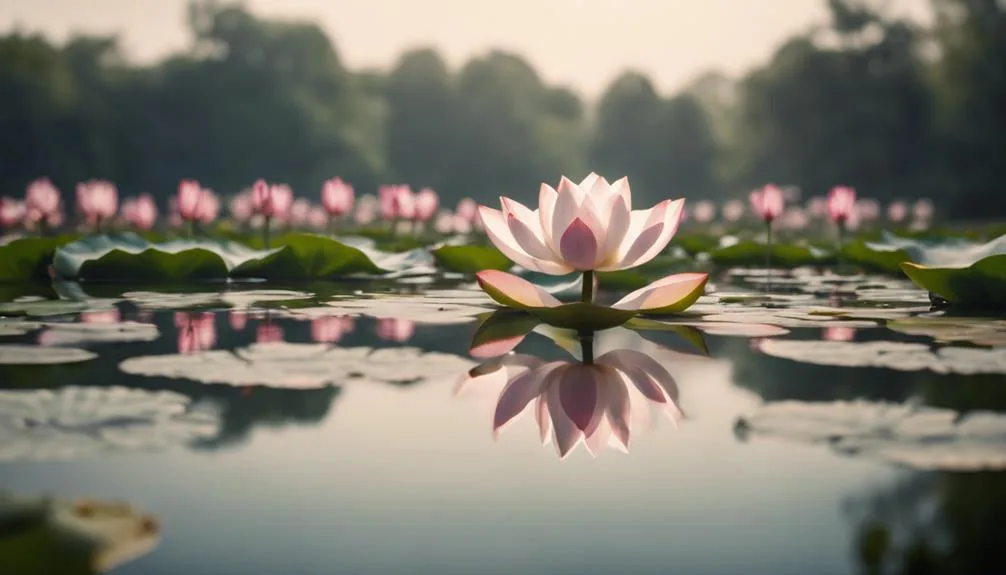Buddhist Meditation Practices Unveiled: Shamatha Vs. Vipashyana
In a world where the quest for inner peace often leads us down the rabbit hole of the latest wellness trends, we've decided to turn our gaze to the ancient practices of Shamatha and Vipashyana.
Together, we're setting out to understand how these traditional Buddhist meditation techniques can offer more than just a trendy escape from our daily grind. By comparing the tranquility-focused approach of Shamatha with the insight-oriented path of Vipashyana, we aim to uncover how each practice shapes our mental landscape.
Our journey promises to reveal intriguing insights about their interplay and the profound impact they can have on our quest for mental clarity and emotional balance. Stick with us as we embark on this exploration, and you might just find the peace you've been searching for.
Key Takeaways
- Shamatha meditation cultivates peace and relaxation through focused concentration.
- Vipashyana meditation offers insight and understanding by transcending the rational mind.
- Shamatha serves as a foundational practice essential for the deeper insights achieved in Vipashyana.
- Both meditation types are integral to Buddhist practice, each addressing different aspects of the path to liberation.
Understanding Buddhist Meditation
To truly grasp the essence of Buddhist meditation, it's crucial to understand the distinct practices of Shamatha and Vipashyana, which form the core of this spiritual discipline. We often encounter misconceptions suggesting that meditation solely aims at relaxation or detachment from reality. However, these practices offer far more profound benefits.
Shamatha centers on cultivating a peaceful, focused mind, laying the groundwork for the deeper insights Vipashyana provides. Through Vipashyana, we delve into the nature of our existence, fostering a clear understanding of the mind and reality. Together, they unlock a path to emotional well-being, enhanced awareness, and ultimately, liberation.
It's essential we recognize the unique roles and advantages each brings to our spiritual journey, dispelling any myths that undersell their transformative potential.
The Essence of Shamatha
While exploring the realm of Buddhist meditation, we find that Shamatha serves as the foundational practice, essential for achieving a state of profound peace and mental clarity. Its importance cannot be overstated, as it lays the groundwork for all further meditative exploration. Shamatha centers on the cultivation of tranquility, allowing us to reach unprecedented levels of focus and relaxation.
| Element | Description | Outcome |
|---|---|---|
| Importance | Foundation for meditation | Stability in practice |
| Tranquility | Cultivation of peace | Mental clarity |
| Focus | Single-pointed concentration | Profound relaxation |
We're committed to understanding the essence of Shamatha, recognizing its pivotal role in guiding us toward a serene and focused state of being. This practice not only prepares us for deeper insights but also enriches our daily lives with peace and mindfulness.
The Path of Vipashyana

We now delve into the transformative journey of Vipashyana meditation, where insight and clarity of mind become the focal points of our practice. This path is marked by:
- Insightful exploration of our thoughts and emotions, peeling away layers of misconception.
- Mindful reflection on the impermanent nature of all phenomena, leading to a profound understanding of reality.
- Analytical depth in our meditation, challenging our preconceived notions and beliefs.
- Self-awareness journey that fosters a deep sense of inner peace and liberation from the ego.
Vipashyana encourages us to confront the essence of our being, leading to an awakening that's both transformative and enlightening. Through this practice, we cultivate a profound self-awareness and an unshakable clarity of mind.
Key Benefits of Shamatha
Delving into the key benefits of Shamatha meditation, it's evident that this practice significantly enhances our focus and emotional well-being. By centering our attention on a single point, whether it's our breath or a mantra, we train our minds to remain in the present moment, improving focus and clarity. This heightened state of awareness allows us to engage more fully with the task at hand, reducing the scatterbrain effect that plagues many of us in our daily lives.
Moreover, Shamatha serves as a powerful tool for stress reduction. As we cultivate a sense of inner calm and peace, our stress levels naturally diminish. This not only improves our overall emotional health but also has a ripple effect, enhancing our relationships and productivity. Through Shamatha, we find a sanctuary of tranquility within, a refuge from the chaos of the external world.
Insights Gained From Vipashyana

Exploring Vipashyana, we uncover profound insights into the nature of our minds, fostering a deeper understanding of our thoughts and emotions. Through our meditation experiences, we've made several insightful observations:
- Vipashyana reveals the impermanent nature of our thoughts, allowing us to detach and find peace.
- It uncovers the interconnectedness of all beings, fostering a deep sense of compassion.
- We recognize the root of our suffering lies in attachment and aversion, guiding us towards liberation.
- Insight into the true nature of reality emerges, leading to a profound inner transformation.
These insights transform not just our meditation practice, but how we engage with the world, making Vipashyana a cornerstone in our path to enlightenment.
Techniques in Shamatha Practice
To enhance our practice of Shamatha meditation, it's essential to familiarize ourselves with its foundational techniques, which aim at cultivating a state of calm and focused attention.
| Technique | Focus Area | Benefit |
|---|---|---|
| Breath Awareness | Breathing Pattern | Enhances concentration and calmness. |
| Visualization | Mental Imagery | Promotes mental clarity and peace. |
| Mantra Repetition | Repetitive Sounds | Builds focus and quiets the mind. |
| Body Scan | Physical Sensations | Increases bodily awareness and relaxation. |
| Counting Breaths | Breath Count | Aids in maintaining focus on the present. |
These practices guide us toward a deeper tranquility, setting the foundation for a fruitful meditation journey.
Exploring Vipashyana Methods

In our journey through Buddhist meditation practices, we now turn our focus to the methods of Vipashyana, which aim at cultivating deep insight and understanding. As we delve into exploring analysis and insightful practices, consider the varied techniques that form the cornerstone of Vipashyana:
- Observation of the Mind: Engaging in a meticulous examination of thoughts and emotions as they arise, fostering a profound understanding of their transient nature.
- Contemplation on Impermanence: Reflecting on the ever-changing aspects of existence, leading to a deeper realization of the nature of reality.
- Analyzing the Self: Investigating the concept of self and ego, unraveling the illusions that bind us.
- Mindfulness in Action: Incorporating mindfulness into daily activities, enhancing awareness and presence in the moment.
These methods guide us toward liberating insights, illuminating the path to true understanding and wisdom.
Shamatha and Vipashyana: A Comparison
Both Shamatha and Vipashyana play crucial roles in Buddhist meditation practices, yet they serve distinct purposes and lead to different outcomes. We find it vital to understand their unique attributes and how they complement each other in the journey towards enlightenment. Here's a concise comparison:
| Aspect | Shamatha | Vipashyana |
|---|---|---|
| Focus | Tranquility | Wisdom |
| Goal | Mindfulness and peace | Insight and clear seeing |
| Practice Differences | Single-pointed concentration | Analytical and non-analytical |
| Outcomes | Emotional well-being, relaxation | Understanding, self-awareness |
We see that mindfulness vs. insight and tranquility vs. wisdom represent the core meditation contrasts between Shamatha and Vipashyana. Each practice enriches the other, paving a path to a more profound spiritual understanding and liberation.
The Sequential Journey

Understanding the distinct paths of Shamatha and Vipashyana meditation, we now explore their sequential journey toward enlightenment. This progression isn't merely a linear path but a mindful unfolding that leads to profound inner transformation.
- Initial Calm: We begin with Shamatha, cultivating a serene and focused mind. This stage lays the groundwork for all subsequent inner work, establishing the peace necessary for deeper exploration.
- Mindful Observation: As stability is achieved, we transition into Vipashyana, engaging in mindful progression that sharpens our insight into the nature of reality.
- Insight Deepening: Through Vipashyana, insights become more profound, leading to enlightened awareness and a deeper understanding of the self and the universe.
- Inner Transformation: This synergy of practices fosters a transformative process, culminating in a profound change within, marked by peace, insight, and enlightened awareness.
Cultivating a Balanced Practice
To cultivate a balanced practice, we must skillfully integrate the tranquil focus of Shamatha with the profound insight of Vipashyana. Balancing tranquility and gaining insight are not separate endeavors but complementary paths that enrich our meditation journey. By harmonizing these practices, we pave a path toward a more profound understanding and experience of mindfulness.
| Aspect | Shamatha | Vipashyana |
|---|---|---|
| Focus | Calming the mind | Gaining insight |
| Technique | Single-pointed concentration | Analytical and non-analytical |
| Aim | Developing tranquility | Understanding reality |
| Foundation | Stability of mind | Insight based on stability |
| Outcome | Emotional well-being | Liberation from attachment |
Together, we embark on this journey, not just seeking peace or insight alone but weaving them into the fabric of our daily lives.
Frequently Asked Questions
Can Buddhist Meditation Practices Like Shamatha and Vipashyana Be Effectively Integrated Into a Non-Buddhist or Secular Lifestyle, and if So, How?
We believe integrating shamatha and vipashyana into a non-Buddhist lifestyle offers secular benefits, such as enhanced mindfulness and emotional well-being. By adapting these practices, we can cultivate a deeper sense of peace and insight in daily life.
Are There Specific Physical Postures or Environments That Significantly Enhance the Practice of Shamatha or Vipashyana Meditation, Beyond the Basic Recommendations for Quiet and Comfort?
We've discovered that using candle focus during shamatha enhances concentration, while the aroma of incense during vipashyana deepens insight. These elements act as bridges, guiding us to a more profound meditation experience.
We've found that integrating shamatha into vipashyana poses unique challenges. Our personal experiences highlight the importance of patience and adaptability, as we navigate the delicate balance between focused calmness and insightful awareness in our practice.
In What Ways Do Shamatha and Vipashyana Meditation Practices Impact the Physiological Aspects of the Body, Such as the Nervous System, Stress Levels, or Brain Function?
We've discovered that both shamatha and vipashyana practices can be like a balm, soothing our nervous system, enhancing heart rate variability, and fortifying our immune response, leading to a profound transformation in our physiological well-being.
How Do Different Buddhist Traditions Interpret and Practice Shamatha and Vipashyana Meditation Differently, and What Are Some Examples of These Variations?
We've noticed that various Buddhist traditions interpret and practice shamatha and vipashyana meditation differently, reflecting historical origins and cultural adaptations. These variations offer a rich tapestry of techniques tailoring to diverse spiritual needs and contexts.
Conclusion
In our exploration, we've uncovered the complementary nature of Shamatha and Vipashyana, revealing a profound path to inner peace and insight. By first establishing a foundation of calm through Shamatha, we've learned we're better equipped to delve into the deeper insights Vipashyana offers.
This sequential approach not only deepens our meditation practice but also enhances our overall well-being. Our journey confirms the theory that a balanced practice incorporating both methods leads to a more mindful and liberated existence.






